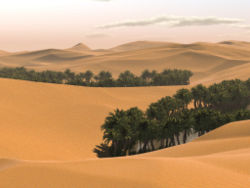Desert
 From Conservapedia - Reading time: 1 min
From Conservapedia - Reading time: 1 min
Deserts are regions of extreme dryness, with less than 5 inches of rain a year. In some deserts, evaporation is greater than rainfall, making them very dry. Semi-arid deserts average 5 to 10 inches of annual rain. Desert moisture is brief and unpredictable from year to year. One-third of Earth desert or semidesert.
Evaporation contributes greatly to a desert's dryness. In some deserts, the amount of water evaporating exceeds the amount of rainfall making that desert very dry. Rising air cools and can holds less moisture, producing clouds and precipitation; falling air warms, absorbing moisture. Areas with few clouds, bodies of water and little vegetation absorb most of the sun's radiation, heating the air at the surface. More humid areas deflect heat in clouds, water and vegetation, remaining cooler. High wind in open country also contributes to evaporation.
Locations of deserts have changed throughout the years. Modern deserts are in the horse latitudes, typically the Tropic of Cancer and the Tropic of Capricorn, between 15 and 30 degrees north and south of the equator. Some deserts, such as the Kalahari in central Africa, are very old. The Sahara Desert in northern Africa is quite old, as is the Sonoran Desert of North America. Deserts can also occur at near-polar latitudes, for example in Iceland or Antarctica.
Because they are poised in such harsh extremes of temperature and aridity, deserts are among the most fragile ecosystems on the planet.
 KSF
KSF